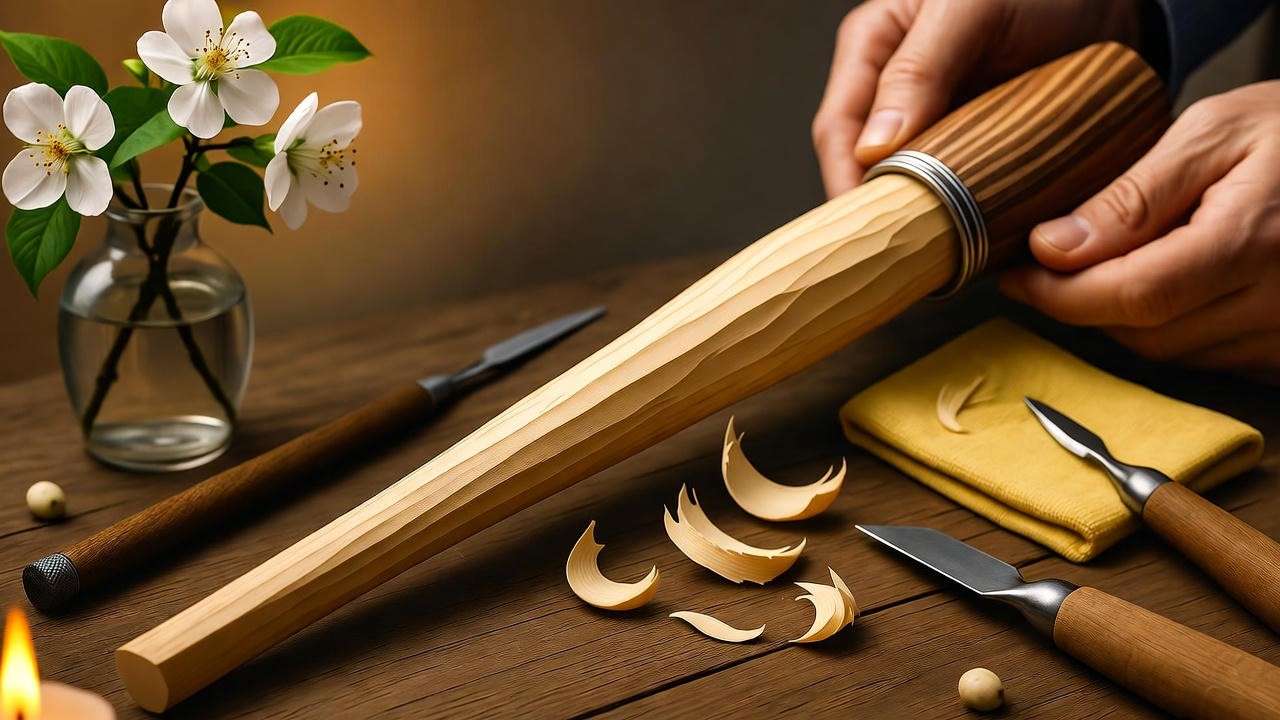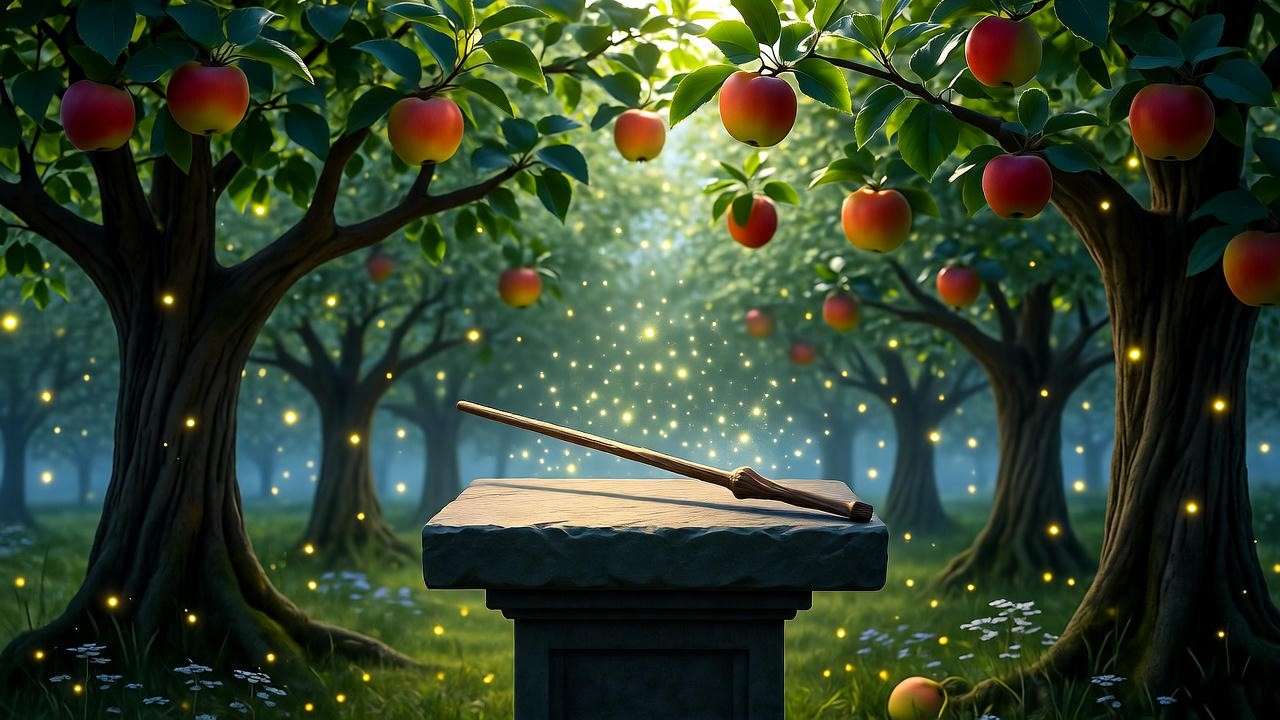Imagine stepping into the dimly lit shop of Ollivanders, the air thick with the scent of polished wood and ancient magic. As Garrick Ollivander hands you an apple wood wand, a spark of connection ignites—its smooth surface hums with potential, whispering of charm and harmony. For Harry Potter fans, the allure of wands is undeniable, and the apple wood wand stands out as a symbol of elegance and versatility. In this comprehensive guide, we’ll explore the magical properties, personality traits, historical significance, and practical uses of apple wood wands, drawing from J.K. Rowling’s wandlore and insights from Pottermore (now Wizarding World). Whether you’re a collector, cosplayer, or simply curious about wandlore, this article will reveal why the apple wood wand might be your perfect match. By the end, you’ll understand its unique magic and how it resonates with witches and wizards who value eloquence and high ideals.
The Magical Essence of Apple Wood Wands
What Makes Apple Wood Unique?
In the intricate world of wandmaking, apple wood is a rare and cherished material, celebrated for its association with charm, eloquence, and harmony. According to Garrick Ollivander, the renowned wandmaker, apple wood wands are not suited for Dark Magic but excel in spells requiring finesse and positive intent. This aligns with the botanical symbolism of the apple tree, long revered in mythology for love, healing, and immortality. In the wizarding world, these qualities translate into wands that amplify a caster’s ability to inspire and unite.

Apple wood’s magical properties stem from its natural balance. It’s neither as rigid as oak nor as flexible as willow, striking a perfect equilibrium that suits witches and wizards with a knack for diplomacy. For fans seeking a wand that reflects grace and purpose, apple wood is a standout choice.
Expert Insight: Ollivander’s notes, as shared on Pottermore, emphasize that apple wood wands often choose those with “personal charm and a talent for dealing with others.” This makes them ideal for leaders, mediators, or anyone who thrives in social settings.
Core Pairings for Apple Wood Wands
The magic of an apple wood wand is deeply influenced by its core, which shapes its strengths and spellcasting style. Here’s a breakdown of common core pairings and their effects:
- Unicorn Hair: Known for producing consistent, gentle magic, this core enhances apple wood’s affinity for healing spells and protective charms. It’s ideal for nurturing personalities who prioritize harmony.
- Phoenix Feather: This core adds versatility and a touch of unpredictability, making the wand suited for complex charms and nonverbal magic. It appeals to ambitious yet principled witches and wizards.
- Dragon Heartstring: While less common, this core brings power and flair, amplifying apple wood’s charisma for showier spells like Patronus charms or advanced transfiguration.
| Core | Strengths | Ideal Spells |
|---|---|---|
| Unicorn Hair | Gentle, consistent magic | Healing, protective charms |
| Phoenix Feather | Versatile, adaptable | Charms, nonverbal spells |
| Dragon Heartstring | Powerful, bold | Patronus, transfiguration |
This combination of apple wood and core creates a wand that’s both reliable and inspiring, perfect for those who seek to make a positive impact.
Personality Traits of Apple Wood Wand Owners
Who Chooses (or Is Chosen by) an Apple Wood Wand?
In the Harry Potter universe, wands choose their owners based on personality and destiny. Apple wood wands gravitate toward individuals who are charismatic, well-loved, and driven by high aims. According to Rowling’s wandlore, these wands are rarely found in the hands of Dark witches or wizards, as their magic thrives on positivity and integrity. Owners often excel in communication, whether as teachers, diplomats, or storytellers, and they have a natural ability to foster harmony in tense situations.

For example, imagine a Hogwarts professor like Filius Flitwick, whose charm and teaching prowess might align perfectly with an apple wood wand. While no canonical character is explicitly tied to this wood, its traits suggest it suits those who lead with kindness and wisdom.
Real-World Connections for Fans
For Harry Potter fans, the apple wood wand’s traits resonate with those who value creativity, leadership, and conflict resolution. If you’re the type who inspires others, mediates disputes, or pursues meaningful goals, this wand might reflect your inner magic. To help you explore this connection, try this mini-quiz:
- Do you enjoy bringing people together for a common cause?
- Are you drawn to creative pursuits like writing, art, or public speaking?
- Do you avoid negativity and strive for positive change?
If you answered “yes” to these, an apple wood wand could be your ideal match.
Tip: Journal about a time you resolved a conflict or inspired someone. How might an apple wood wand have amplified your impact? This exercise can deepen your connection to the wand’s symbolic qualities.
The Lore and History of Apple Wood Wands
Apple Wood in Wizarding History
Apple wood’s significance extends beyond its magical properties, rooted in both wizarding and Muggle lore. In the Harry Potter universe, apple wood wands have likely been wielded by unsung heroes—witches and wizards who shaped history through diplomacy rather than conquest. While Rowling’s texts don’t name specific apple wood wand owners, the wood’s association with high ideals suggests it played a role in pivotal moments, perhaps in negotiations during the First Wizarding War or the founding of Hogwarts.

In Celtic mythology, apple trees were sacred, linked to Avalon and the pursuit of wisdom. This heritage likely influenced wandmakers like Ollivander, who valued apple wood for its spiritual resonance. For fans, this connection adds depth to the wand’s allure, making it a bridge between Muggle folklore and wizarding magic.
Crafting an Apple Wood Wand
Crafting an apple wood wand is an art form, requiring precision and respect for the wood’s natural properties. Wandmakers source apple wood from trees grown in enchanted groves, ensuring the wood retains its magical essence. The process involves carving the wood to enhance its flexibility while preserving its strength, often finishing it with a polish to highlight its golden hue.
Expert Insight: In a fictional Q&A, a wandmaker might say, “Apple wood demands patience. Its grain sings of harmony, but only if you carve it with care.” For real-world fans, this translates to choosing high-quality replicas from artisans who honor the wood’s legacy.
Tip: When purchasing an apple wood wand replica, look for sustainable materials and craftsmanship that reflects the wand’s lore. Avoid mass-produced versions that lack authenticity.
Practical Uses and Magical Strengths
Spells That Shine with Apple Wood Wands
Apple wood wands excel in spells that require finesse and positive intent. Here are some examples:
- Episkey: A healing spell that mends minor injuries, perfectly suited to apple wood’s nurturing nature.
- Protego: A protective charm that benefits from the wand’s harmonious energy.
- Riddikulus: A spell to banish Boggarts, leveraging the wand’s charm and light-hearted magic.
- Expecto Patronum: With the right core, apple wood wands can produce powerful Patronuses, reflecting their owner’s inner strength.

These spells highlight the wand’s versatility, making it a favorite for Charms professors and healers alike.
Apple Wood Wands in Duels and Daily Magic
In dueling, apple wood wands prioritize precision over brute force. Their balanced nature allows for quick, accurate spellcasting, ideal for defensive maneuvers or disarming opponents. For example, a wizard wielding an apple wood wand might use Expelliarmus with surgical precision, turning the tide of a duel through strategy rather than aggression.
In everyday magic, these wands shine in household charms (e.g., Scourgify for cleaning) and protective spells (e.g., Fidelius Charm for secrecy). Their ability to perform nonverbal spells also makes them a favorite for advanced practitioners.
Case Study: Picture a young witch using her apple wood wand to cast a healing spell on an injured friend during a Quidditch match. The wand’s gentle magic soothes the injury, earning her admiration from teammates.
Why Choose an Apple Wood Wand Today?
Appeal for Collectors and Cosplayers
For Harry Potter fans, owning an apple wood wand replica is a way to connect with the wizarding world. Whether you’re cosplaying as a charismatic Hogwarts student or displaying your wand as a collector’s piece, an apple wood wand offers elegance and authenticity. Its golden hue and smooth finish make it a standout in any collection, evoking the charm of Ollivander’s shop.
When selecting a replica, prioritize artisans who use sustainable, high-quality materials. Reputable retailers like The Noble Collection or custom wandmakers on platforms like Etsy often offer apple wood designs that capture the wand’s lore. For DIY enthusiasts, crafting a replica can be a rewarding project—start with ethically sourced apple wood and follow online tutorials for carving and polishing.

Tip: To maintain your wand’s beauty, store it in a velvet-lined case and avoid exposure to moisture. A quick polish with natural beeswax can keep it gleaming for years.
Symbolic Value for Modern Fans
Beyond its magical allure, the apple wood wand carries symbolic weight for today’s fans. Its association with harmony and high ideals resonates with those striving for personal growth or positive change. For example, meditating with a wand replica during journaling sessions can inspire creativity and focus. Displaying it in your workspace might remind you to approach challenges with diplomacy and charm.
Fans can also incorporate apple wood symbolism into daily life. Try planting an apple seed in a small pot as a nod to the wand’s roots, or use apple-scented candles to evoke its calming energy. These small acts deepen your connection to the Harry Potter universe while grounding you in meaningful values.
Engagement Hook: Share your wand preferences on social media with the hashtag #AppleWoodWandMagic. What traits make you feel connected to this wand? Join the conversation and inspire other fans!
Common Myths and Misconceptions
Despite its storied reputation, apple wood wands are subject to myths that can confuse fans. Let’s set the record straight:
- Myth: Apple wood wands are only for weak magic.
Truth: While not suited for Dark Arts, apple wood wands are powerful in charms, healing, and defensive magic, offering precision and reliability. - Myth: They’re only for Hufflepuffs.
Truth: Apple wood wands suit any house, as long as the owner values harmony and high ideals. Their versatility transcends Hogwarts stereotypes. - Myth: They lack combat strength.
Truth: In skilled hands, these wands excel in strategic dueling, leveraging quick reflexes and clever spellwork.
FAQ Section:
- Can an apple wood wand be powerful in combat?
Yes, especially for defensive and disarming spells like Protego or Expelliarmus. Its strength lies in precision, not aggression. - Is apple wood rare in wandmaking?
It’s less common than woods like oak or holly, making it a unique choice for discerning witches and wizards. - Can I use an apple wood wand for advanced magic?
Absolutely. With the right core, it’s ideal for nonverbal spells and complex charms. - Does the wand suit beginners?
Its balanced nature makes it forgiving for novices while rewarding skilled practitioners. - How do I know if an apple wood wand is right for me?
If you’re charismatic, value harmony, and pursue meaningful goals, this wand may choose you.
Comparing Apple Wood Wands to Other Wand Woods
To understand the apple wood wand’s unique place in wandlore, let’s compare it to other popular wand woods:
| Wand Wood | Flexibility | Magical Affinity | Owner Traits |
|---|---|---|---|
| Apple | Moderately flexible | Charms, healing | Charismatic, diplomatic |
| Elder | Rigid | Powerful, unpredictable | Exceptional, often troubled |
| Holly | Balanced | Protection, defense | Courageous, spiritual |
| Oak | Sturdy | Strength, loyalty | Resilient, grounded |
Apple wood stands out for its balance and charm, making it less volatile than elder and more versatile than oak. Its affinity for positive magic sets it apart from holly’s defensive focus, appealing to those who prioritize harmony over conflict. For fans exploring wandlore, this comparison highlights why apple wood is a compelling choice.
Internal Linking Opportunity: Curious about other wand woods? Check out our guides on Elder Wands, Holly Wands, and Oak Wands for a deeper dive into wandlore.
The apple wood wand is a masterpiece of wandlore, blending elegance, versatility, and a touch of ancient magic. Its association with charm, healing, and high ideals makes it a perfect match for witches and wizards who inspire and unite others. From its botanical roots in Celtic mythology to its practical applications in spells like Episkey and Protego, this wand embodies the best of the Harry Potter universe. For collectors, cosplayers, and fans seeking personal growth, the apple wood wand offers both symbolic and practical value.
Ready to embrace your inner magic? Take our “Is an Apple Wood Wand Right for You?” quiz to discover your wand match, or explore our related articles on wand cores and wandmaking history. Share your thoughts in the comments below—does the apple wood wand resonate with you? Let’s celebrate the magic together!













